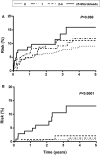Long-Term Prognostic Implications of Cerebral Microbleeds in Chinese Patients With Ischemic Stroke
- PMID: 29217662
- PMCID: PMC5779045
- DOI: 10.1161/JAHA.117.007360
Long-Term Prognostic Implications of Cerebral Microbleeds in Chinese Patients With Ischemic Stroke
Abstract
Background: This study was performed to determine the clinical correlates and long-term prognostic implications of microbleed burden and location in Chinese patients with ischemic stroke.
Methods and results: We recruited 1003 predominantly Chinese patients with ischemic stroke who received magnetic resonance imaging at the University of Hong Kong. We determined the clinical correlates of microbleeds and the long-term risks (3126 patient-years of follow-up) of recurrent ischemic stroke and intracerebral hemorrhage (ICH) by microbleed burden (0 versus 1, 2-4, and ≥5) and location, adjusting for age, sex, and vascular risk factors and stratified by antithrombotic use. Microbleeds were present in 450 of 1003 of the study population (119/450 had ≥5, 187/450 had mixed location). Having ≥5 microbleeds was independently associated with prior antiplatelet and anticoagulant use, whereas microbleeds of mixed location were independently associated with hypertension and prior anticoagulant use (all P<0.05). Microbleed burden was associated with an increased risk of ICH (microbleed burden versus no microbleeds: 1 microbleed: multivariate hazard ratio: 0.59 [95% confidence interval, 0.07-5.05]; 2-4 microbleeds: multivariate hazard ratio: 2.14 [95% confidence interval, 0.50-9.12]; ≥5 microbleeds: multivariate hazard ratio: 9.51 [95% confidence interval, 3.25-27.81]; Ptrend<0.0001), but the relationship of microbleed burden and risk of recurrent ischemic stroke was not significant (Ptrend=0.054). Similar findings were noted in the 862 of 1003 patients treated with antiplatelet agents only (ICH: Ptrend<0.0001; ischemic stroke Ptrend=0.096). Multivariate analysis revealed that, independent of vascular risk factors, antithrombotic use, and other neuroimaging markers of small vessel disease, having ≥5 microbleeds (multivariate hazard ratio: 6.08 [95% confidence interval, 1.11-33.21]; P=0.037) was identified as an independent predictor of subsequent ICH, but neither microbleed burden nor location was predictive of recurrent ischemic stroke risk.
Conclusions: In Chinese patients with ischemic stroke, a high burden of cerebral microbleeds was significantly associated with an increased risk of ICH; however, neither microbleed location nor burden was associated with recurrent ischemic stroke risk.
Keywords: cerebral microbleed; intracerebral hemorrhage; ischemic stroke.
© 2017 The Authors. Published on behalf of the American Heart Association, Inc., by Wiley.
Figures


References
-
- Cordonnier C, Al‐Shahi Salman R, Wardlaw J. Spontaneous brain microbleeds: systematic review, subgroup analyses and standards for study design and reporting. Brain. 2007;130:1988–2003. - PubMed
-
- Fisher M. Cerebral microbleeds: where are we now? Neurology. 2014;83:1304–1305. - PubMed
-
- van Veluw SJ, Biessels GJ, Klijn CJ, Rozemuller AJ. Heterogeneous histopathology of cortical microbleeds in cerebral amyloid angiopathy. Neurology. 2016;86:867–871. - PubMed
-
- Wilson D, Charidimou A, Ambler G, Fox ZV, Gregoire S, Rayson P, Imaizumi T, Fluri F, Naka H, Horstmann S, Veltkamp R, Rothwell PM, Kwa VI, Thijs V, Lee YS, Kim YD, Huang Y, Wong KS, Jager HR, Werring DJ. Recurrent stroke risk and cerebral microbleed burden in ischemic stroke and TIA: a meta‐analysis. Neurology. 2016;87:1501–1510. - PMC - PubMed
-
- Cheng AL, Batool S, McCreary CR, Lauzon ML, Frayne R, Goyal M, Smith EE. Susceptibility‐weighted imaging is more reliable than T2*‐weighted gradient‐recalled echo MRI for detecting microbleeds. Stroke. 2013;44:2782–2786. - PubMed
MeSH terms
LinkOut - more resources
Full Text Sources
Other Literature Sources
Medical

